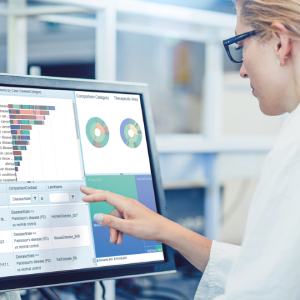














Interpretation of genomic variants in tumor samples still presents a challenge in clinical settings. Variant interpretation is fragmented across disparate databases, and aggregation of information from these requires building extensive infrastructure. The Human Somatic Mutation Database (HSMD) is an easy-to-use, somatic database from QIAGEN that contains extensive genomic content relevant to solid tumors and hematological malignancies. Pulling content from over 500,000 real-world clinical oncology cases and 40+ databases contained in the QIAGEN Knowledge Base, HSMD gives genetic counselors access to over 1.7 million somatic variants characterized in over 1,400 cancer-related genes. To demonstrate the efficiency and clinical utility of HSMD, we present a use-case for using the database to assess the biological and clinical relevance of anaplastic lymphoma kinase (ALK) gene.
About 3-7% of patients with non-small cell lung cancer (NSCLC) have rearrangements in the ALK gene. These genetic alterations are relatively rare compared with epidermal growth factor receptor (EGFR) or KRAS mutations (1). ALK rearrangements are often seen in people who don’t smoke and who are younger. These oncogenic mutations lead to the constitutive activation of the ALK tyrosine kinase domain, a protein that causes cancer cells to grow and spread. To date, several therapies have been developed to target ALK gene changes, known as ALK inhibitors. These include, Crizotinib (Xalkori), Ceritinib (Zykadia), Alectinib (Alecensa), Brigatinib (Alunbrig), and Lorlatinib (Lorbrena).
Therefore, clinical diagnostic labs that perform somatic genomic testing need to be able to define the precise biological function and clinical actionability of ALK mutations. However, given their relatively rarity, ALK mutations require thorough assessment and curation to accurately interpret their clinical significance and recommend effective treatment strategies.
HSMD is a web-based database that provides deep insight into small variants, such as SNVs, indels, frameshifts, fusions and copy number variants that have been clinically observed or curated from scientific literature to help users better understand and define precise function and actionability. Unlike other somatic databases, such as ClinVar and Genomenon that use crowdsourcing or human-absent machine learning, HSMD uses augmented molecular intelligence—the combination of machine learning and human curation—to curate each somatic variant. The result is higher quality data that is up-to-date, consistent, comprehensive, and accurate. This focus on human effort, review and certification is critical. It means clinical diagnostic labs can trust the data in HSMD and proceed with confidence to interpret and report somatic tests.
Here, we present a step-by-step use-case of how your clinical diagnostic lab can use HSMD to search and explore mutational characteristics across the ALK gene, synthesize key findings from drug labels, clinical trials, and professional guidelines, and receive detailed annotations for each observed variant.
HSMD is a web-based application. When you open the interface, the homepage provides five search options. Users can search by Gene, Alteration, Disease, Drug, or Clinical Trial (Figure 1).

Search by gene: When you search by gene in HSMD, you access the total number of genes listed in the database. You can then further narrow your search by viewing data from the QIAGEN Knowledge Base or focusing exclusively on clinically observed variants.
When you search for ALK p.F1174L in HSMD, you receive a description of the alteration with links to relevant literature, external links to the alteration in ClinVar, dbSNP, and OncoKB, and a summary of alteration details, including chromosome position, alteration type, functional impact, and population frequency (Figure 2).

Once you narrow your focus to searching for only clinically observed variants, you receive a table and distribution graph that shows the number of observed clinical cases for a particular gene across all cancer types.
Continuing the example using ALK p.F1174L, you can clearly see the alteration’s distribution by disease through a table and graph. As you scroll down, you receive information on it's biological impact, as well as the gene’s frequency in different populations (Figure 3). You can also view the biological impact and allele frequency (Figure 4).
Click to enlarge the images.


HSMD enables you to view relevant drugs and clinical trials for a ALK p.F1174L. You receive a list of drugs approved for use with ALK p.F1174L (Figure 5a), as well as recruiting clinical trials for that alteration (Figure 5b). In addition, HSMD provides an extensive bibliography for ALK p.F1174L, with clickable links to each article (Figure 6).
Click to enlarge the images.



As demonstrated by the use-case, incorporating HSMD into your somatic variant interpretation workflow enables you to easily search and explore mutational characteristics across genes, synthesize key findings from drug labels, clinical trials, and professional guidelines, and receive detailed annotations for each observed variant. With HSMD, you can efficiently ask and answer the following key questions:
HSMD is a one-stop shop for all the content a clinical diagnostic lab needs to assess the biological relevance and clinical actionable of somatic variants. QIAGEN Digital Insights offers free, no-obligation trials of HSMD. You can see what kind of content the database offers, explore the search functionality, and determine if this database can save you time and money.
Take the first step. Request a free trial of HSMD here.
Want to learn more?
Explore HSMD resources, videos, and use-cases here.
Need a FASTQ to final report solution for oncology NGS testing?
QCI Interpret for Oncology is an end-to-end solution for NGS data analysis, interpretation, and reporting that helps clinical diagnostic labs scale the process of FASTQ to final report.
QCI Interpret provides a comprehensive and flexible reporting system that automatically incorporates significant variants, key findings, annotation sources, and interpretation summaries. Reports can be fully customized to meet your lab’s brand and formatting requirements. This sample report is for a pan-cancer multimodal panel and shows results with TMB and MSI biomarkers and a KRAS alteration detected.
Over the last 20 years, molecular analysis of cancers has offered clinicians a growing toolbox for understanding and treating cancer. Next-generation sequencing (NGS) of tumors identifies alterations that can predict sensitivity and resistance to targeted therapies as well as ascribe prognostic and diagnostic significance. As sequencing power and research into cancer-causing mutations have grown, the number of genes on panels has increased.
In 2022, typical panels can detect hundreds of thousands of mutations across several hundred cancer-related genes. In some cases, laboratories perform exome analysis to detect mutations across all ~22,000 genes in the genome. As a result, the burden of variant interpretation has also expanded exponentially.
Numerous clinical decision support (CDS) software and knowledgebases have been developed to assist variant scientists and laboratory directors with the task of variant classification. These private and commercially available systems utilize varying degrees of software automation and manually curated literature to provide variant assessment and therapy matching for clinicians. The body of literature that must be accessed to deliver accurate variant interpretation is vast. As a result, there is debate in the field as to the most accurate and efficient approach.
CDS software leveraging artificial intelligence or natural language processing can index enormous volumes of literature but lack precision in correctly representing complex genomic interactions in association with clinical outcomes. In this context, human curation remains the gold standard. A community crowdsourcing approach allows contribution from many different experts and can help to build a larger pool of knowledge in the context of limited resources.
However, significant standardization efforts are required to ensure a consistent level of accuracy and reliability. In contrast to machine curation, human professional expert curation is resource intensive but can provide consistent and accurate interpretation.

QIAGEN Clinical Insight (QCI) Interpret for Oncology is CDS software that enables pathologists to identify biologically and clinically relevant oncology-related variants. The software draws on a large knowledgebase of curated information, coupled with an expert interpretation service. The content core of QCI Interpret, the QIAGEN Knowledge Base is populated through a combined approach utilizing human and machine curation. Known as augmented molecular intelligence (AMI), this approach combines artificial intelligence and human expertise to advance and accelerate confident clinical decision-making.
A key differentiator of QCI Interpret, the application of AMI leverages artificial intelligence and machine
learning to efficiently identify, extract, and align evidence from scientific literature, guidelines, clinical trials, and drug labels in over 40 public and proprietary databases in the QIAGEN Knowledge Base. This evidence is then reviewed by over 200 PhD- and MDlevel scientists to ensure accuracy, consistency, and
relevance. The evidence is then stored in computable units according to well-defined protocols.
QCI Interpret utilizes the structured content of the QIAGEN Knowledge Base to match appropriate variant- and disease-specific content and executes rules to classify variant pathogenicity and actionability based on the ACMG (1) and AMP (2) guidelines. The computed classification and supporting data are available for review in a user interface. And the user has the ability to review all the data and approve or revise the classification.
QCI Interpret also incorporates an additional level of human expert interpretation. Users can submit variants to the expert interpretation service and oncologists review the clinical content.
The expert interpretation available in QCI Interpret utilizes a contrasting analysis approach; the scientists execute a topic-based analysis, searching for and extracting information on each variant and formulating an assessment based on the synthesis of the evidence. Then, the usesr receives report-ready text with references to incorporate into the final report. Users can easily view the expert classification and interpretation alongside the computed classification, and the user can approve or revise the classification for reporting.
Multiple studies compare variant classification across institutions (3-5). However, these studies lack a “gold standard” set of variant interpretations that could stand as a benchmark for evaluation.
In order to assess the utility and accuracy of QCI Interpret, QIAGEN engaged GenQA, an external quality assessment organization. GenQA designed and executed a study published in the Journal of Molecular Pathology that compared the use of QCI Interpret to internal laboratory methods. The study recruited eight independent laboratories to utilize QCI Interpret for variant interpretation. Variant classification results were compared and an expert panel resolved all conflicts. The results suggest QCI Interpret is a reliable CDS tool that can help laboratories streamline and improve interpretation practices.
Learn more about the study, including how QCI Interpret performed against the 8 laboratories, sources of discrepancies, and methods of variant analysis.
November 1-5, 2022 in Phoenix, Arizona
This year at the Association for Molecular Pathology (AMP) 2022 Annual Meeting, QIAGEN will be showcasing our integrated cancer NGS workflow powered by augmented molecular intelligence (AMI) at Booth #906. The combination of artificial intelligence and human expertise, AMI is an approach unique to QIAGEN. AMI uses machines to rapidly index millions of articles. Then, human curators review and certify the accuracy, relevancy, and consistency of the information pulled.
Learn more and schedule a 1:1 demo here.